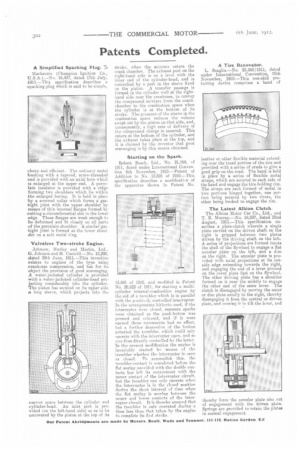Patents Completed.
Page 26

If you've noticed an error in this article please click here to report it so we can fix it.
A Simplified Sparking Plug.
Mackenzie (Champion Ignition Co., U.S.A.).—No. 16,437, dated 17th July, 1911.—This specification describes a sparking-plug which is said to be simple, cheap and efficient. The ordinary metal bushing with a tapered, screw-threaded and is provided with an axial bore which is enlarged at the upper end. A porcelain insulator is provided with a ridge forming two shoulders which lie within the enlarged boring. It is held in place by a screwed collar which forms a gastight joint with the upper shoulder by anemia of thin internal flanges formed by cutting a circumferential slot in the lower edge. These flanges are weak enough to be deformed and fit closely on all parts of the porcelain shoulder. A similar gastight joint is formed at the lower shoul tier on a soft metal ring.
Valveless Two-stroke Engine.
Johnson, Hurley and Martin, Ltd.. G. Johnson and H. Cantrill.—No. 15,298. elated 30th June, 1911.—This invention relates to engines of _the type using crankcase compression, and has for its object the provision of good scavenging. A water-jacketed cylinder is provided with a water-jacketed cylinder-head projecting considerably into the cylinder.
he piston has secured on its upper side a long sleeve, which projects into the narrow space between the cylinder and cylinder-head. An inlet port is provided (on the left-hand side) so as to be uncovered by the piston at the top of its
stroke, when the mixture enters the crank chamber. The exhaust port on the right-hand side is on a level with the inner end of the cylinder-head, and is controlled by a port in the sleeve fixed on the piston. A transfer passage is formed, in the cylinder wall at the righthand side near the crankcase, to convey the compressed mixture from the crankchamber to the combustion space when the cylinder is at the bottom of its stroke. The presence of the sleeve in the combustion space reduces the volume swept out by the piston on that side, and, consequently, a high rate of delivery of the compressed charge is ensured. This enters at the bottom of the cylinder, and the exhaust takes place at the top, and it is claimed by the inventor that good scavenging is by this means obtained.
Starting on the Spark.
Robert Bosch, Ltd., No. 21,169, 44 1911, dated under International Convention 8th November, 1910.—Patent of Addition to No. 13,691 of 1910.—This specification describes a modificatien of the apparatus shown in Patent No.
13,691 of 1910, and modified in Patent No. 20,623 of 1911, for starting a multicylinder internal-combustion engine by the aid of a trembler which is in parallel with the pasitively controlled interrupter. In the arrangements hitherto used, if the interrupter were closed, separate sparks were obtained as the push-button was pressed and released, and if it were opened these movements had no effect, but a further depression of the button actuated the trembler. which could only operate with the interrupter open, and so was thus directly controlled by the latter. In the nresent modification the engine is invariably started lw means of the trembler whether the interrupter is open or clesed. To accomplish this, the trembler-contact is comnleted before the flat spring provided with the double eon. tacts has left its enenzement with the miner contact. of the inte.rrupteer circuit. hut the trembler can only operate when the interrupter is in the closed position durine the short interval of time when the flat amine is moving between the upper and lower contacts of the interrupter circuit. It is thereby ensured that the trembler is only (elevated durine time less then thet taken by the engine to complete its first stroke.
A Tire Renovator.
L. Scaglia.—No. 25,360/1911, dated under International Convention, 15th November, 1910.—This non-skid protecting device comprises a band of
leather or other flexible material extending over the tread portion of the tire and provided with a series of studs to give a good grip on the road. The band is held in place by a series of flexible metal straps, which are secured to each side of the band and engage the tire-holding rim. The straps are each formed of metal in two portions hinged together, one portion being secured by two rivets, the other being hooked to engage the rim.
The Latest Albion Clutch.
The Albion Motor Car Co., Ltd., and T. B. Murray.—No. 18,837, dated 22nd August, 1911.—This specification describes a plate-clutch wherein a single plate carried on the driven shaft on the right is gripped between two plates driven by the driving shaft on the left. A series of projections are formed inside the shell of the flywheel to engage a flat annular plate on the left, and a disc on the right. The annular plate is provided with axial projections at its outside edge extending towards the right, and engaging the end of a lever pivoted on the cover plate fast on the flywheel. The other driving plate has a sloulder formed on it near the middle to engage the other end of the same lever. The clutch is disengaged by moving the outer or disc plate axially to the right, thereby disengaging it from the central or driven plate, and causine it to tilt the lever, and
thereby force the annular plate also out of engagement with the driven plate. Springs are provided to retain the plates in normal engagement.


























